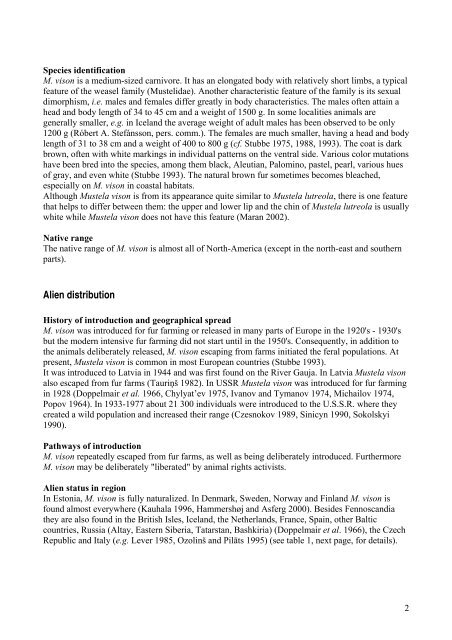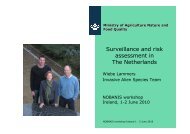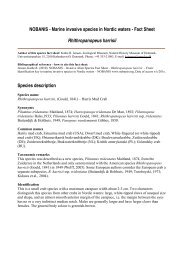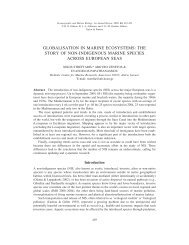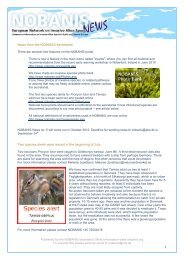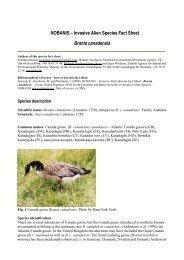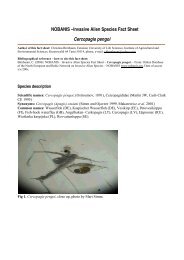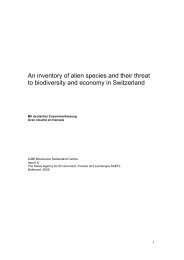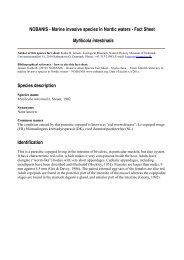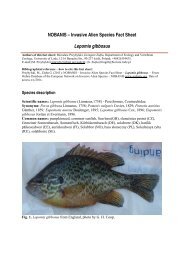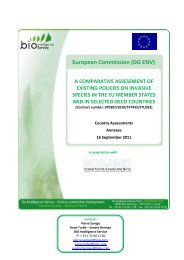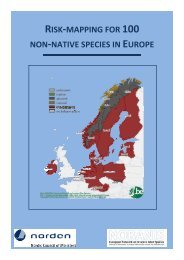Invasive Alien Species Fact Sheet – Mustela vison - NOBANIS
Invasive Alien Species Fact Sheet – Mustela vison - NOBANIS
Invasive Alien Species Fact Sheet – Mustela vison - NOBANIS
You also want an ePaper? Increase the reach of your titles
YUMPU automatically turns print PDFs into web optimized ePapers that Google loves.
<strong>Species</strong> identification<br />
M. <strong>vison</strong> is a medium-sized carnivore. It has an elongated body with relatively short limbs, a typical<br />
feature of the weasel family (Mustelidae). Another characteristic feature of the family is its sexual<br />
dimorphism, i.e. males and females differ greatly in body characteristics. The males often attain a<br />
head and body length of 34 to 45 cm and a weight of 1500 g. In some localities animals are<br />
generally smaller, e.g. in Iceland the average weight of adult males has been observed to be only<br />
1200 g (Róbert A. Stefánsson, pers. comm.). The females are much smaller, having a head and body<br />
length of 31 to 38 cm and a weight of 400 to 800 g (cf. Stubbe 1975, 1988, 1993). The coat is dark<br />
brown, often with white markings in individual patterns on the ventral side. Various color mutations<br />
have been bred into the species, among them black, Aleutian, Palomino, pastel, pearl, various hues<br />
of gray, and even white (Stubbe 1993). The natural brown fur sometimes becomes bleached,<br />
especially on M. <strong>vison</strong> in coastal habitats.<br />
Although <strong>Mustela</strong> <strong>vison</strong> is from its appearance quite similar to <strong>Mustela</strong> lutreola, there is one feature<br />
that helps to differ between them: the upper and lower lip and the chin of <strong>Mustela</strong> lutreola is usually<br />
white while <strong>Mustela</strong> <strong>vison</strong> does not have this feature (Maran 2002).<br />
Native range<br />
The native range of M. <strong>vison</strong> is almost all of North-America (except in the north-east and southern<br />
parts).<br />
<strong>Alien</strong> distribution<br />
History of introduction and geographical spread<br />
M. <strong>vison</strong> was introduced for fur farming or released in many parts of Europe in the 1920's - 1930's<br />
but the modern intensive fur farming did not start until in the 1950's. Consequently, in addition to<br />
the animals deliberately released, M. <strong>vison</strong> escaping from farms initiated the feral populations. At<br />
present, <strong>Mustela</strong> <strong>vison</strong> is common in most European countries (Stubbe 1993).<br />
It was introduced to Latvia in 1944 and was first found on the River Gauja. In Latvia <strong>Mustela</strong> <strong>vison</strong><br />
also escaped from fur farms (Tauriņš 1982). In USSR <strong>Mustela</strong> <strong>vison</strong> was introduced for fur farming<br />
in 1928 (Doppelmair et al. 1966, Chylyat’ev 1975, Ivanov and Tymanov 1974, Michailov 1974,<br />
Popov 1964). In 1933-1977 about 21 300 individuals were introduced to the U.S.S.R. where they<br />
created a wild population and increased their range (Czesnokov 1989, Sinicyn 1990, Sokolskyi<br />
1990).<br />
Pathways of introduction<br />
M. <strong>vison</strong> repeatedly escaped from fur farms, as well as being deliberately introduced. Furthermore<br />
M. <strong>vison</strong> may be deliberately "liberated" by animal rights activists.<br />
<strong>Alien</strong> status in region<br />
In Estonia, M. <strong>vison</strong> is fully naturalized. In Denmark, Sweden, Norway and Finland M. <strong>vison</strong> is<br />
found almost everywhere (Kauhala 1996, Hammershøj and Asferg 2000). Besides Fennoscandia<br />
they are also found in the British Isles, Iceland, the Netherlands, France, Spain, other Baltic<br />
countries, Russia (Altay, Eastern Siberia, Tatarstan, Bashkiria) (Doppelmair et al. 1966), the Czech<br />
Republic and Italy (e.g. Lever 1985, Ozolinš and Pilāts 1995) (see table 1, next page, for details).<br />
2


